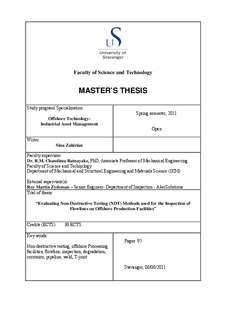| dc.contributor.author | Zahirian, Sina | |
| dc.date.accessioned | 2011-10-25T15:40:44Z | |
| dc.date.available | 2011-10-25T15:40:44Z | |
| dc.date.issued | 2011 | |
| dc.identifier.uri | http://hdl.handle.net/11250/182824 | |
| dc.description | Master's thesis in Offshore technology | en_US |
| dc.description.abstract | The importance and criticality of the processes and equipments within the Oil & Gas industry
highlights the requirement for more reliable, available and maintainable production activities and
facilities. These requirements can be fulfilled by prevention of failures through reducing the
downtime and wastage of material. Besides, prevention of failures helps the companies to stay away
from their unwanted catastrophic consequences. Therefore, having effective and efficient inspection
and maintenance management programs seems to be of paramount importance to keep all these
facilities in process. Among all the inspection methods, the use of Non-Destructive Testing (NDT)
methods is increasing rapidly due to their remarkable advantages such as high quality, accuracy,
flexibility, and etc. which are of interest for those who are involved with inspection and
maintenance programs. All the advantages of NDT methods encourage companies to apply them for
the inspection of flowlines which have the most criticality among all the processing equipments.
Among all NDT methods, Radiographic Testing and Ultrasonic Testing are among the most used
ones for the inspection of flowlines. These methods are explained within this thesis to see their
limitations, advantages and disadvantages. Thereafter, all NDT methods applied for the inspection
of flowlines on offshore production facilities are evaluated to see which ones have had more
accurate and reliable results. The frequency of these methods is also investigated in this dissertation.
Aforementioned evaluations reveal the most important influencing factors that can affect the
frequency and accuracy of each particular NDT method. Underlying reasons of some exotic results
which companies may confront within their inspection plans and programs are also pointed out in
this manuscript. All these factors and influencing parameters can be used in developing matrixes
and frameworks for the selection of the proper NDT method(s) which should be used for inspection
purposes. Some of the matrixes that are in-use by one of the leading companies in Oil & Gas
industry are updated regarding the results of mentioned evaluations. The thesis is carried out with
one of the leading engineering services providing companies located in the Norwegian Continental
Shelf (NCF). | en_US |
| dc.language.iso | eng | en_US |
| dc.publisher | University of Stavanger, Norway | en_US |
| dc.relation.ispartofseries | Masteroppgave/UIS-TN-IKM/2011; | |
| dc.subject | offshore teknologi | en_US |
| dc.subject | non-destructive testing | en_US |
| dc.subject | inspection | en_US |
| dc.subject | flowline | en_US |
| dc.subject | driftsledelse | en_US |
| dc.title | Evaluating non-destructive testing (ndt) methods used for the inspection of flowlines on offshore production facilities | en_US |
| dc.type | Master thesis | en_US |
| dc.subject.nsi | VDP::Technology: 500::Marine technology: 580::Offshore technology: 581 | en_US |
